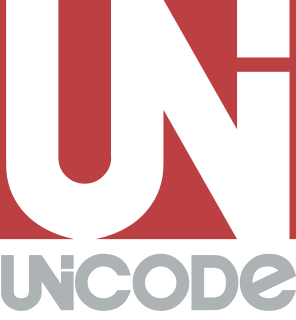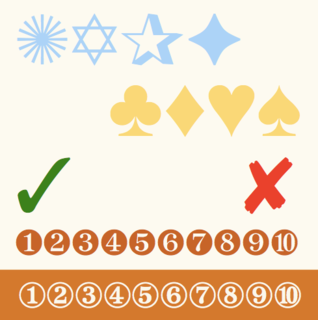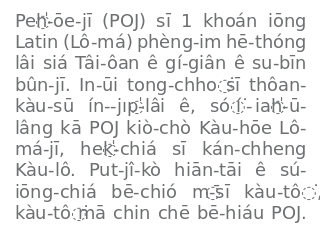
Unicode is a computing industry standard for the consistent encoding, representation, and handling of text expressed in most of the world's writing systems. The standard is maintained by the Unicode Consortium, and as of June 2018 the most recent version, Unicode 11.0, contains a repertoire of 137,439 characters covering 146 modern and historic scripts, as well as multiple symbol sets and emoji. The character repertoire of the Unicode Standard is synchronized with ISO/IEC 10646, and both are code-for-code identical.
Big-5 or Big5 is a Chinese character encoding method used in Taiwan, Hong Kong, and Macau for traditional Chinese characters.
Han unification is an effort by the authors of Unicode and the Universal Character Set to map multiple character sets of the so-called CJK languages into a single set of unified characters. Han characters are a common feature of written Chinese (hanzi), Japanese (kanji), and Korean (hanja).

In typography, a dingbat is an ornament, character, or spacer used in typesetting, often employed for the creation of box frames. The term continues to be used in the computer industry to describe fonts that have symbols and shapes in the positions designated for alphabetical or numeric characters.
In digital typography, the TrueType font Arial Unicode MS is an extended version of the font Arial. Compared to Arial, it includes higher line height, omits kerning pairs and adds enough glyphs to cover a large subset of Unicode 2.1—thus supporting most Microsoft code pages, but also requiring much more storage space. It also adds Ideographic layout tables, but unlike Arial, it mandates no smoothing in the 14–18 point range, and contains Roman (upright) glyphs only; there is no oblique (italic) version. Arial Unicode MS is normally distributed with Microsoft Office, but it is also bundled with Mac OS X v10.5 and later. It may also be purchased separately from Ascender Corporation, who licenses the font from Microsoft.
In Unicode, a Private Use Area (PUA) is a range of code points that, by definition, will not be assigned characters by the Unicode Consortium. Currently, three private use areas are defined: one in the Basic Multilingual Plane (U+E000–U+F8FF), and one each in, and nearly covering, planes 15 and 16. The code points in these areas cannot be considered as standardized characters in Unicode itself. They are intentionally left undefined so that third parties may define their own characters without conflicting with Unicode Consortium assignments. Under the Unicode Stability Policy, the Private Use Areas will remain allocated for that purpose in all future Unicode versions.

ITC Zapf Dingbats is one of the more common dingbat typefaces. It was designed by the typographer Hermann Zapf in 1978 and licensed by International Typeface Corporation.
A Unicode font is a computer font that maps glyphs to Unicode characters. The vast majority of modern computer fonts use Unicode mappings, even those fonts which only include glyphs for a single writing system, or even only support the basic Latin alphabet. Fonts which support a wide range of Unicode scripts and Unicode symbols are sometimes referred to as "pan-Unicode fonts", although as the maximum number of glyphs that can be defined in a TrueType font is restricted to 65,535, it is not possible for a single font to provide individual glyphs for all defined Unicode characters. This article lists some widely-used Unicode fonts that support a comparatively large number and broad range of Unicode characters.
The Chinese, Japanese and Korean (CJK) scripts share a common background, collectively known as CJK characters. In the process called Han unification, the common (shared) characters were identified and named CJK Unified Ideographs. As of Unicode 11.0, Unicode defines a total of 87,887 CJK Unified Ideographs.

Radical 213 meaning "turtle" is one of only two of the 214 Kangxi radicals that are composed of 16 strokes.

In CJK computing, graphic characters are traditionally classed into fullwidth and halfwidth characters. With fixed-width fonts, a halfwidth character occupies half the width of a fullwidth character, hence the name.
Code2000 is a serif and pan-Unicode digital font, which includes characters and symbols from a very large range of writing systems. As of the current final version 1.171 released in 2008, Code2000 is designed and implemented by James Kass to include as much of the Unicode 5.2 standard as practical, and to support OpenType digital typography features. Code2000 supports the Basic Multilingual Plane. Code2001 and Code2002, related beta fonts created by James Kass, support characters in higher Unicode planes.
Zhuyin Fuhao, Zhuyin, Bopomofo (ㄅㄆㄇㄈ) or Mandarin Phonetic Symbols is the major Chinese transliteration system for Taiwanese Mandarin. It is also used to transcribe other varieties of Chinese, particularly other varieties of Standard Chinese and related Mandarin dialects, as well as Taiwanese Hokkien.
Phofsit Daibuun (PSDB) is an orthography in the Latin alphabet for Taiwanese Hokkien based on Modern Literal Taiwanese. It is able to use the ASCII character set to indicate the proper variation of pitch without any subsidiary scripts or diacritic symbols.

WenQuanYi is an open-source project of Chinese computer fonts licensed under GNU General Public License.
The Burmese script is the basis of the alphabets used for modern Burmese, Mon, Shan and Karen.

Noto is a font family comprising over a hundred individual fonts, which are together designed to cover all the scripts encoded in the Unicode standard. As of October 2016 Noto fonts cover all 93 scripts defined in Unicode version 6.0, although less than 30,000 of the nearly 75,000 CJK unified ideographs in version 6.0 are covered. In total Noto fonts cover nearly 64,000 characters, which is under half of the 137,439 characters defined in Unicode 11.0.








